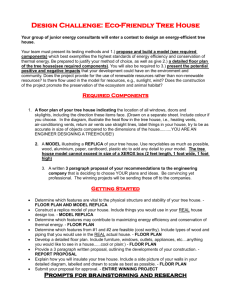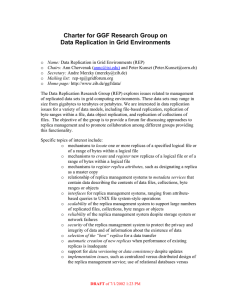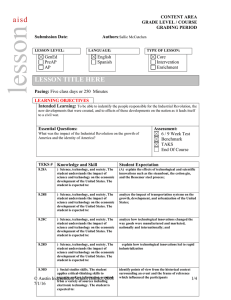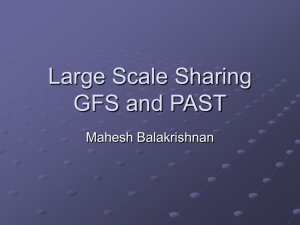Replica Inspection for High-Temperature Components
advertisement
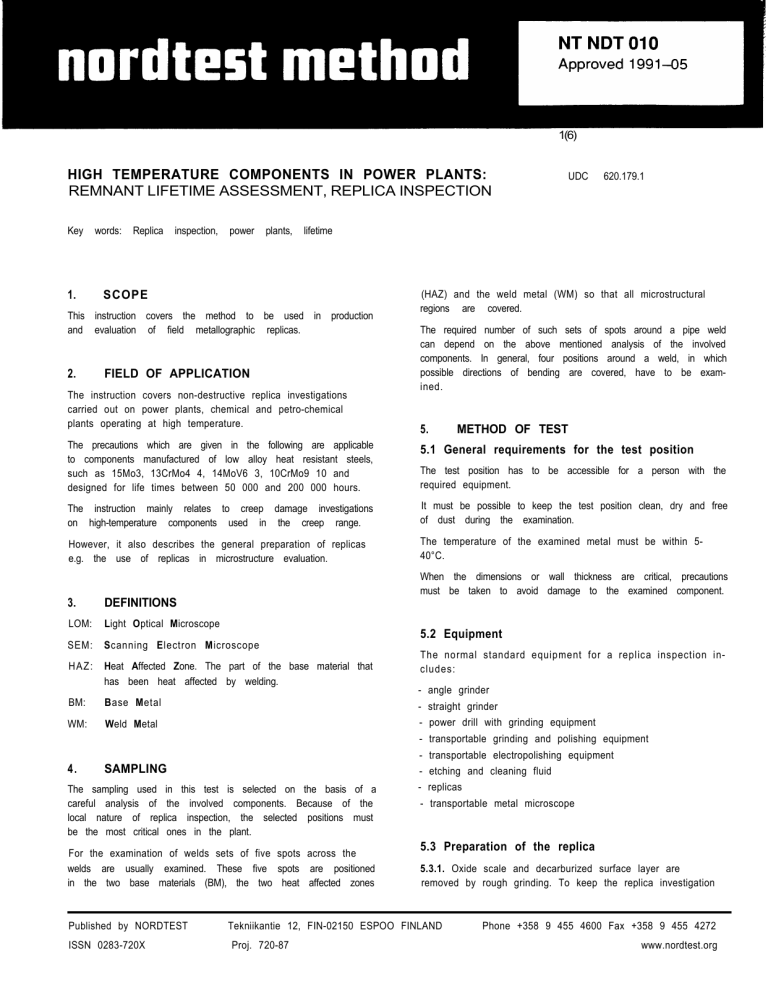
1(6) HIGH TEMPERATURE COMPONENTS IN POWER PLANTS: REMNANT LIFETIME ASSESSMENT, REPLICA INSPECTION UDC 620.179.1 Key words: Replica inspection, power plants, lifetime 1. SCOPE This instruction covers the method to be used in production and evaluation of field metallographic replicas. 2. FIELD OF APPLICATION The instruction covers non-destructive replica investigations carried out on power plants, chemical and petro-chemical plants operating at high temperature. (HAZ) and the weld metal (WM) so that all microstructural regions are covered. The required number of such sets of spots around a pipe weld can depend on the above mentioned analysis of the involved components. In general, four positions around a weld, in which possible directions of bending are covered, have to be examined. 5. METHOD OF TEST The precautions which are given in the following are applicable to components manufactured of low alloy heat resistant steels, such as 15Mo3, 13CrMo4 4, 14MoV6 3, 10CrMo9 10 and designed for life times between 50 000 and 200 000 hours. 5.1 General requirements for the test position The instruction mainly relates to creep damage investigations on high-temperature components used in the creep range. It must be possible to keep the test position clean, dry and free of dust during the examination. However, it also describes the general preparation of replicas e.g. the use of replicas in microstructure evaluation. The temperature of the examined metal must be within 540°C. The test position has to be accessible for a person with the required equipment. When the dimensions or wall thickness are critical, precautions must be taken to avoid damage to the examined component. 3. DEFINITIONS LOM: Light Optical Microscope 5.2 Equipment SEM: Scanning Electron Microscope HAZ: Heat Affected Zone. The part of the base material that has been heat affected by welding. BM: Base Metal WM: Weld Metal 4. SAMPLING The sampling used in this test is selected on the basis of a careful analysis of the involved components. Because of the local nature of replica inspection, the selected positions must be the most critical ones in the plant. For the examination of welds sets of five spots across the welds are usually examined. These five spots are positioned in the two base materials (BM), the two heat affected zones Published by NORDTEST ISSN 0283-720X The normal standard equipment for a replica inspection includes: - angle grinder - straight grinder - power drill with grinding equipment - transportable grinding and polishing equipment transportable electropolishing equipment etching and cleaning fluid replicas - transportable metal microscope 5.3 Preparation of the replica 5.3.1. Oxide scale and decarburized surface layer are removed by rough grinding. To keep the replica investigation Tekniikantie 12, FIN-02150 ESPOO FINLAND Proj. 720-87 Phone +358 9 455 4600 Fax +358 9 455 4272 www.nordtest.org NORDTEST METHOD non-destructive the total material removed by grinding, must not exeed 0,5-1 mm. NT NDT 010 2 The quality of the produced replica is judged visually. In case of doubt a transportable metal microscope is used. 5.3.2. The following grinding has to be done in at least 3 steps with successively finer grades of paper ending with emery paper No 400. For each type of emery paper, the grinding time must be 3 times the time needed to remove the traces from the previous grinding. The cutting direction should be altered by 90° between each grade. Recommended grades of emery paper are No 120, 220 and 400 in that order. While grinding only little pressure must be used to prevent heating and deformation of the surface. 5.4 Aftercare of replicas After the preparation of replicas these may be coated with aluminium or other light reflecting and conductive material under vacuum to improve the contrast in the light optical microscope (LOM). This also makes it possible to use the coated replica in the Scanning Electron Microscope (SEM). While being coated and examined in SEM, the replicas should be exposed to a minimum of heat. 5.5 Evaluation 5.3.3. If a weld or a repair weld is examined, macroetching must be carried out between grinding and polishing. This makes the weld metal (WM) and the heat affected zones (HAZ) visible. 5.3.4. After grinding and macro etching the selected area must be polished. This is done in one of the following two ways. - Electropolishing with transportable electropolishing equipment. - Mechanical polishing with polishing disk and alumina solution or diamond paste or -spray to finishing grain size 1 µm. The personnel evaluating the produced replicas must have a metallurgical education and practical training in this kind of work. The produced replicas can be inspected in LOM or SEM. Normally the examination is made in LOM, but cases may appear where the expanded depth of field and resolution in SEM is needed. The represented area must be examined with regard to microstructure and defects. The total polished area must be examined. When macro-cracks are detected it is recommended that mechanical polishing is performed, which does not affect the crack faces strongly. If electropolishing is carried out it should be performed after examination of the mechanically polished surface. The report on creep damage must, unless other instructions are given, conform to the guidelines given on form 1 in the Appendix “Evaluation of creep damage”. 5.3.5. Depending upon the examined metal and the required information an appropriate etchant and etching time has to be selected. The re-examination intervals are approximate. They are given for a situation where operational data before and after the examination are the same. Factors such as changes of operational data and frequent shut-downs and start-ups can involve shorter intervals for re-examination. In case of non-alloyed or low-alloyed steels 2-5 % Nital is a suitable standard etchant. After etching the etched area must be rinsed with alcohol and dried with a hot-air dryer to obtain a clean, dry and dust free surface. 5.3.6. The surface is now ready for examination. This can be done either in the laboratory by replicas or in special cases in-situ with a transportable metal microscope. To be able to produce replicas of satisfactory quality the surface must be kept clean, dry and free from dust. The replica (normally made of a thin plastic foil) is softened with a solvent and pressed against the surface until the replica has again hardened. To avoid air bubbles under the replica it should be pressed on to the surface from the middle towards the edges. The replica must be pulled off very carefully to avoid bends, fingerprints etc. To protect the produced replica it is mounted on a microscope slide and kept dry and free of dust. The classification of creep damage on form 1 in the Appendix is applicable for electropolished surfaces. Each position is characterized in accordance with the above mentioned guidelines, e.g. 2.1 HAZ, which means that single cavities to a small extent have been found in the heat affected zone (HAZ). The written report may for documentation purposes include photos of the microstructure if wanted, or if the examined area cannot be fully characterized according to the above guide lines. At the end of an inspection it must be verified that all relevant information is to be found on shown forms 2 and 3 in the Appendix. 6. DOCUMENTATION AND STORAGE The produced replicas are kept in archive boxes. Both the single replicas and the archive boxes shall be marked with reference No and replica position. The archive boxes are furthermore marked with name of client, plant and component. NORDTEST METHOD 7. APPENDIX Form 1: Basic guidelines for evaluation of creep damage. Form 2: Field report on replica inspection. Form 3: Evaluation report. NT NDT 010 3 8. REFERENCES DIN 54150 - 1977, Abdruckverfahren für die Oberflächenprüfung (Replica Technik). ISO 3057 - 1974, Non-destructive testing - Metallographic replica techniques of surface examinations. ASTM ES 12-87, Emergency Standard Practice for Production and evaluation of field Metallographic Replicas. NORDTEST METHOD NT NDT 010 4 FORM 1 BASIC GUIDELINES FOR EVALUATION OF CREEP DAMAGE Creep cracks-cavities CLASS DAMAGE DEGREE. NATURE*. RECOMMENDATIONS. PRECAUTION. 1 No creep cavities None 2 Single cavities Re-examine after app. 20,000 hours of operation. 3 Coherent cavities Re-examine after app. 15,000 hours of operation. 4 Creep cracks (micro) Re-examine after app. 10,000 hours of operation. 5 Creep cracks (macro) The plant is contacted immediately. * Nature is described as small (1), medium (2) or large (3) extent. (Example: 2.3: Single cavities in large extent). Position of defect in and around a weld seam: Base Metal
